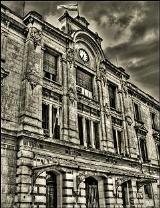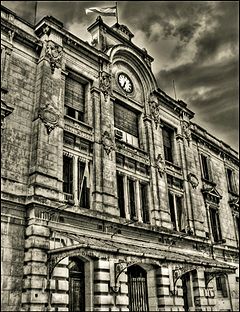
Estación Once
Encyclopedia
Once railway station ("Estación Once" in Spanish
) is a large railway terminus in central Buenos Aires
, Argentina
.
The station, inaugurated on December 20, 1882, is located in the barrio of Balvanera
immediately north of Plaza Miserere
, a large public square. The full official name of the terminus is Estación Once de Septiembre, Spanish
for "11 September Station," named after the September 11, 1852, rebellion of Buenos Aires against the Federal
government of General Justo José de Urquiza
. Once de septiembre is not to be confused with "Once de septiembre de 1888," the commemorated date of the death of President Domingo Faustino Sarmiento
.
 The original terminal, an unassuming clapboard
The original terminal, an unassuming clapboard
structure, was ordered replaced by larger facilities following its 1890 purchase by the Buenos Aires Western Railway
. Designed by architect John Doyer, the new, Renaissance Revival terminal was built in two stages, from 1895 to 1898, and from 1906 to 1907; refurbishment works completed in 1972 removed most of the terminal's ornate, cast-iron roof trusses (though these are still visible in the adjoining subway station).
Estación Once handles both long-distance and local passenger trains. The publicly-owned railway company Ferrobaires
operates trains over four principal rail lines which fan out west over the surrounding Buenos Aires Province
. Destinations include Pehuajó
, Bragado
, and points between. Additionally, the commuter rail company Trenes de Buenos Aires
operates a regular train service to the suburbs of Buenos Aires along the branches of its Linea Sarmiento
to destinations including Moreno Partido
, Luján
, Lobos
, and Mercedes
. The station is accessible by numerous public bus services and by the A line
of the Buenos Aires Metro
via its "Plaza Miserere" station. Estación Once underwent extensive renovations prior to 2007, when the new H line
of the metro reached the heavily transited terminal.
Spanish language
Spanish , also known as Castilian , is a Romance language in the Ibero-Romance group that evolved from several languages and dialects in central-northern Iberia around the 9th century and gradually spread with the expansion of the Kingdom of Castile into central and southern Iberia during the...
) is a large railway terminus in central Buenos Aires
Buenos Aires
Buenos Aires is the capital and largest city of Argentina, and the second-largest metropolitan area in South America, after São Paulo. It is located on the western shore of the estuary of the Río de la Plata, on the southeastern coast of the South American continent...
, Argentina
Argentina
Argentina , officially the Argentine Republic , is the second largest country in South America by land area, after Brazil. It is constituted as a federation of 23 provinces and an autonomous city, Buenos Aires...
.
The station, inaugurated on December 20, 1882, is located in the barrio of Balvanera
Balvanera
Balvanera is a neighborhood of Buenos Aires, Argentina.-Origin of Name and Alternative Names:The official name, Balvanera, is the name of the parroquia centered around the church of Nuestra Señora de Balvanera, erected in 1831.The zone around Corrientes avenue is known as Once after Plaza Once de...
immediately north of Plaza Miserere
Plaza Miserere
The Plaza de Miserere is one of the main plazas of Buenos Aires, Argentina. It is located in the heart of the Balvanera neighborhood. It was supposed to be the name of the Line A—Buenos Aires Metro station located below it, but the station is more popularly known as Plaza Once, and is located...
, a large public square. The full official name of the terminus is Estación Once de Septiembre, Spanish
Spanish language
Spanish , also known as Castilian , is a Romance language in the Ibero-Romance group that evolved from several languages and dialects in central-northern Iberia around the 9th century and gradually spread with the expansion of the Kingdom of Castile into central and southern Iberia during the...
for "11 September Station," named after the September 11, 1852, rebellion of Buenos Aires against the Federal
Federales (Argentina)
Federales was the name under which the supporters of federalism in Argentina were known, opposing the Unitarios that claimed a centralised government of Buenos Aires Province, with no participation of the other provinces of the custom taxes benefits of the Buenos Aires port...
government of General Justo José de Urquiza
Justo José de Urquiza
Justo José de Urquiza y García was an Argentine general and politician. He was president of the Argentine Confederation from 1854 to 1860.He was governor of Entre Ríos during the government of Juan Manuel de Rosas, governor of Buenos Aires with powers delegated from the other provinces...
. Once de septiembre is not to be confused with "Once de septiembre de 1888," the commemorated date of the death of President Domingo Faustino Sarmiento
Domingo Faustino Sarmiento
Domingo Faustino Sarmiento was an Argentine activist, intellectual, writer, statesman and the seventh President of Argentina. His writing spanned a wide range of genres and topics, from journalism to autobiography, to political philosophy and history...
.

Clapboard (architecture)
Clapboard, also known as bevel siding or lap siding or weather-board , is a board used typically for exterior horizontal siding that has one edge thicker than the other and where the board above laps over the one below...
structure, was ordered replaced by larger facilities following its 1890 purchase by the Buenos Aires Western Railway
Buenos Aires Western Railway
The Buenos Aires Western Railway was one of the Big Four broad gauge British-owned companies that built and operated railway networks in Argentina...
. Designed by architect John Doyer, the new, Renaissance Revival terminal was built in two stages, from 1895 to 1898, and from 1906 to 1907; refurbishment works completed in 1972 removed most of the terminal's ornate, cast-iron roof trusses (though these are still visible in the adjoining subway station).
Estación Once handles both long-distance and local passenger trains. The publicly-owned railway company Ferrobaires
Ferrobaires
Ferrobaires S.A. is the commercial name of a public railway company which operates extensive long-distance passenger trains throughout Buenos Aires Province in Argentina. Its official corporate name is Unidad Ejecutora del Plan Ferroviario Provincial , or Executing Unit of the Provincial Railway...
operates trains over four principal rail lines which fan out west over the surrounding Buenos Aires Province
Buenos Aires Province
The Province of Buenos Aires is the largest and most populous province of Argentina. It takes the name from the city of Buenos Aires, which used to be the provincial capital until it was federalized in 1880...
. Destinations include Pehuajó
Pehuajó
Pehuajó is a city in the Pehuajó Partido in the province of Buenos Aires, Argentina. The partido has about 38,400 inhabitants as per the...
, Bragado
Bragado
Bragado is a city in the center-northwest province of Buenos Aires, Argentina, and the head town of Bragado Partido. The city is 210 km west-southwest from Buenos Aires City, not far from the Salado River.-Etymology and Legend:...
, and points between. Additionally, the commuter rail company Trenes de Buenos Aires
Trenes de Buenos Aires
Trenes de Buenos Aires is a privately-owned company which, on 27 May 1995, took over the concession, granted by the Argentine government as part of railway privatisation during the presidency of Carlos Menem, for the operation of commuter rail services in Buenos Aires, Argentina over the broad...
operates a regular train service to the suburbs of Buenos Aires along the branches of its Linea Sarmiento
Línea Sarmiento (Buenos Aires)
The Sarmiento line is a commuter rail service in Buenos Aires, Argentina run by the private company Trenes de Buenos Aires since 27 May 1995. This service had previously been run by the state-owned Ferrocarril Domingo Faustino Sarmiento since nationalisation of the railways in 1948. TBA forms part...
to destinations including Moreno Partido
Moreno Partido
Moreno Partido is a partido of the Buenos Aires Province, Argentina, within the Gran Buenos Aires urban agglomerate. It has an area of 186 square kilometres, and a population of 462,242...
, Luján
Luján, Buenos Aires
Luján is a city in the Buenos Aires province of Argentina, located 68 kilometres north west of the city of Buenos Aires. The city was founded in 1755 and has a population of 94,000 ....
, Lobos
Lobos
Lobos is the head city of the Lobos Partido in the Buenos Aires Province, Argentina, founded on June 2, 1802 by José Salgado.-Background:Located 100 km from Buenos Aires, Lobos is currently a fertile agricultural area known mainly because of the dairy activity and dairy-related products.Lobos...
, and Mercedes
Mercedes, Buenos Aires
Mercedes is a city in the province of Buenos Aires, Argentina. It is located 100 km west from Buenos Aires and 30 km south west of Luján. It is the head town of the district of Mercedes as well as of the judicial district...
. The station is accessible by numerous public bus services and by the A line
Line A (Buenos Aires)
Line A is the oldest line of the Buenos Aires Metro. This historic line runs from Plaza de Mayo to Carabobo, and is scheduled to be extended towards San Pedrito station....
of the Buenos Aires Metro
Buenos Aires Metro
The Buenos Aires Metro , locally known as Subte is a mass-transit system that serves the city of Buenos Aires, Argentina. The first station of this network opened in 1913, the first of its kind in South America, the Southern Hemisphere and the entire Spanish-speaking world...
via its "Plaza Miserere" station. Estación Once underwent extensive renovations prior to 2007, when the new H line
Line H (Buenos Aires)
Line H of the Buenos Aires Metro, is the first entirely new line built in Buenos Aires since the opening of Line E on 20 June 1944. The first phase, between Plaza Once and Caseros, opened 18 October 2007, currently it stretches over 5.5 km between stations Parque Patricios and Corrientes...
of the metro reached the heavily transited terminal.

